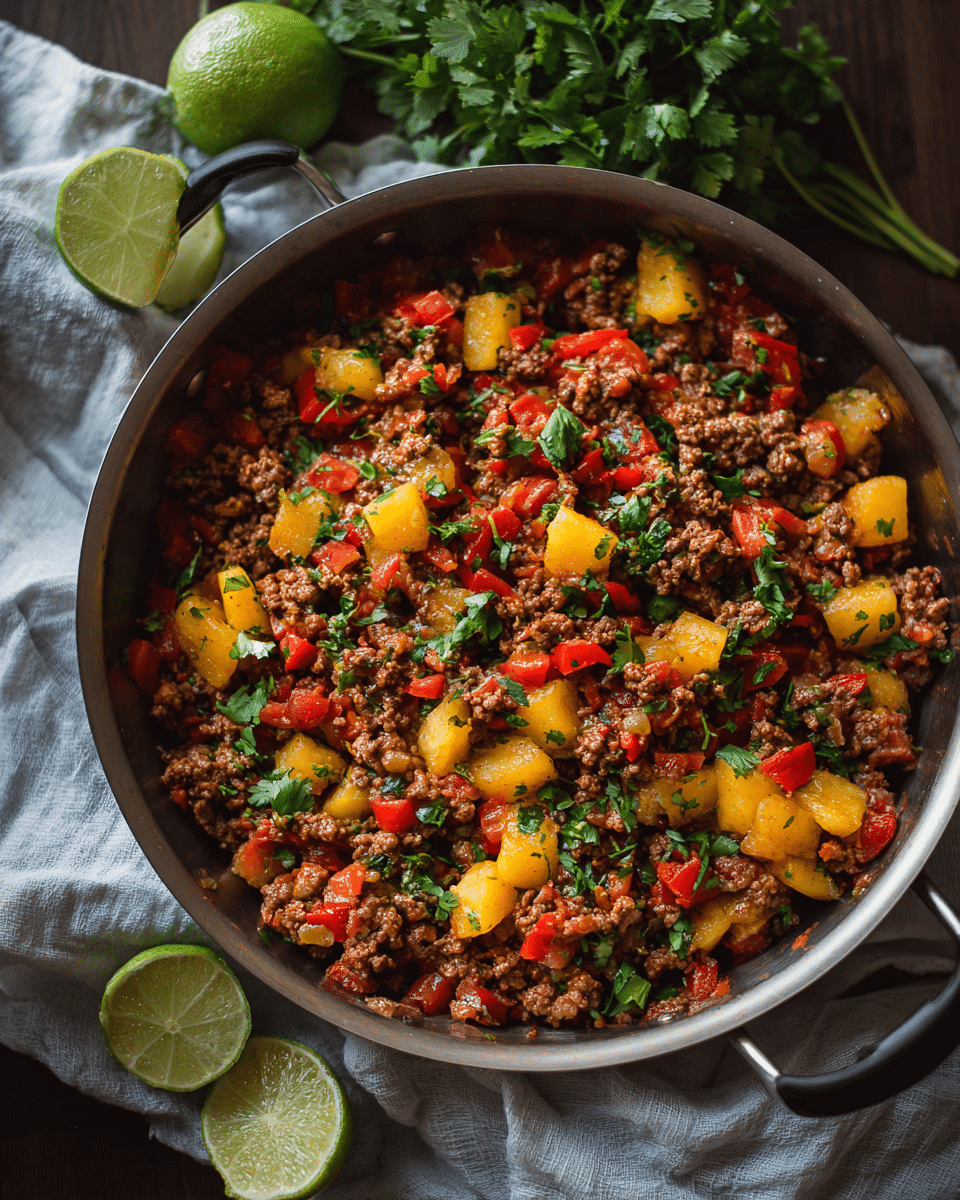Picadillo is a beloved Cuban dish that brings together ground beef, potatoes, olives, and raisins in a rich tomato-based sauce. It’s a perfect harmony of savory and sweet, with layers of flavor that reflect the island’s culinary influences from Spain, Africa, and the Caribbean. This comforting dish is more than just food it’s a celebration of Cuban heritage and family traditions.
Often served with white rice, black beans, and sweet fried plantains, Picadillo is as versatile as it is delicious. Whether prepared for a weeknight dinner or a cultural celebration during Latin-Hispanic Heritage Month, this dish delivers warmth and nostalgia in every bite. Its balance of hearty beef, tangy olives, and a hint of sweetness from raisins makes it a crowd-pleaser that connects people through the shared love of traditional flavors.
Full Recipe
Ingredients:
-
1 lb ground beef
-
2 tbsp olive oil
-
1 medium onion, finely chopped
-
1 green bell pepper, finely chopped
-
3 cloves garlic, minced
-
1 cup tomato sauce
-
1/2 cup beef broth
-
1/3 cup green olives, sliced
-
1/4 cup raisins
-
1 medium potato, peeled and diced
-
1 bay leaf
-
1 tsp ground cumin
-
1 tsp dried oregano
-
1/2 tsp smoked paprika
-
Salt and pepper to taste
-
Fresh cilantro for garnish (optional)
Directions:
-
Heat olive oil in a large skillet over medium heat. Add onions, bell pepper, and garlic; sauté until softened, about 4–5 minutes.
-
Add the ground beef and cook until browned, breaking it apart with a spoon as it cooks. Drain excess fat if necessary.
-
Stir in cumin, oregano, paprika, salt, and pepper, cooking for 1–2 minutes until fragrant.
-
Add tomato sauce, beef broth, diced potato, bay leaf, raisins, and olives. Stir well to combine.
-
Bring the mixture to a simmer, then reduce heat to low. Cover and cook for 20–25 minutes, or until potatoes are tender and sauce is slightly thickened.
-
Adjust seasoning if needed and remove bay leaf.
-
Serve hot, garnished with fresh cilantro. Traditionally enjoyed with white rice, fried plantains, or black beans.
Prep Time: 15 minutes | Cooking Time: 30 minutes | Total Time: 45 minutes
Kcal: 325 kcal | Servings: 4 servings
Cuban Picadillo: A Delicious Taste of Heritage
Cuban Picadillo is a dish that speaks to the soul its rich history and unique combination of flavors make it one of the most beloved comfort foods in Cuba. This hearty dish, which combines ground beef with a medley of vegetables, raisins, olives, and potatoes, is a beautiful representation of Cuba’s diverse cultural influences. A perfect dish to celebrate Latin-Hispanic Heritage Month, Picadillo offers a taste of tradition while being accessible to cooks of all skill levels.
In this article, we’ll explore the history, cultural significance, and various ways to enjoy Cuban Picadillo. We will also share why it has become a symbol of Cuban family cooking and how you can make it in your own kitchen to bring a bit of Cuban flair to your meals.
The History of Picadillo
Picadillo is a dish that reflects Cuba’s rich history of cultural fusion. While the dish is predominantly associated with Cuban cuisine, its origins can be traced to a variety of culinary traditions, including Spanish, African, and Caribbean influences.
Historically, Picadillo was a practical way for families to stretch limited ingredients into a hearty, satisfying meal. The use of ground beef was common, as it was an affordable protein. The addition of vegetables, potatoes, and rice made the dish filling, while olives and raisins provided a touch of sweetness and savory depth.
The Spanish influence on Picadillo is evident in its use of spices such as cumin, oregano, and bay leaves. These ingredients are frequently found in Spanish stews and other savory dishes. The African influence, on the other hand, is often seen in the use of sweet and savory combinations, such as the pairing of raisins with olives, which is a signature element of the dish. The Caribbean twist comes from the rich, aromatic sauce and the addition of potatoes, which give Picadillo its signature texture.
Over time, Picadillo has evolved in Cuba to become a dish enjoyed by all generations. Whether served during major holidays or as a regular weeknight meal, this dish is a true representation of Cuban home cooking.
The Cultural Significance of Picadillo
Picadillo is more than just a meal it’s a symbol of Cuban culture, family, and togetherness. In many Cuban households, the dish is a staple that brings families together around the dinner table. The preparation and enjoyment of Picadillo are often a communal activity, with family members participating in different stages of the cooking process.
During special occasions like holidays, birthdays, or Latin-Hispanic Heritage Month, families often gather to cook and share a large pot of Picadillo. Its affordability and versatility make it an ideal dish for large gatherings. In these settings, the flavors of Picadillo represent the connection between past and present generations, honoring the culinary traditions passed down from those who came before.
For many Cuban-Americans, Picadillo is a bridge between the homeland and the diaspora, a way to stay connected to their roots. The dish has crossed borders and is enjoyed in various Latin American countries, each with its unique regional twist, but the Cuban version remains a symbol of pride for those from the island.
A Fusion of Flavors: Savory Meets Sweet
One of the most intriguing aspects of Cuban Picadillo is the fusion of savory and sweet flavors. While ground beef forms the hearty base of the dish, the addition of raisins, olives, and sometimes capers or almonds adds a complex layer of sweetness, tanginess, and umami.
The raisins, often added toward the end of the cooking process, lend a natural sweetness that contrasts beautifully with the briny flavor of the olives. This combination of flavors creates a unique and well-balanced dish, where no single flavor dominates. The sweetness from the raisins helps mellow out the richness of the beef, making each bite a delightful experience.
The olives are another key element, offering a briny sharpness that cuts through the richness of the meat. The olives used in Picadillo are typically green, which provides a slightly bitter taste that complements the raisins’ sweetness. The contrast between the two ingredients is one of the things that sets Cuban Picadillo apart from other similar dishes found in Latin American or Caribbean cuisine.
The addition of potatoes to the dish not only contributes texture but also helps absorb the flavorful sauce, making each bite satisfying. The soft, creamy potatoes pair perfectly with the beef and olives, adding comfort and substance to the dish.
Modern Twists on the Classic Dish
While the traditional version of Cuban Picadillo is a timeless classic, home cooks have started experimenting with modern variations to give the dish a fresh twist. Some cooks opt to use turkey or chicken instead of ground beef, creating a lighter version of the dish that still maintains the delicious flavor profile. For a plant-based version, some choose to use lentils or textured vegetable protein (TVP) as a substitute for meat, making the dish vegan-friendly.
Additionally, some people like to incorporate different vegetables or herbs to create a new flavor profile. For example, adding bell peppers, carrots, or tomatoes can give the dish more color and depth. While these variations may differ from the traditional recipe, they all maintain the essence of Cuban Picadillo balancing savory and sweet elements in a satisfying and filling meal.
Another modern take on Picadillo is its use as a filling for empanadas or tacos. This variation allows for a more casual, finger-food approach to enjoying the dish while still retaining its signature flavors. Cuban Picadillo can also be served over brown rice or quinoa for a healthier alternative to the traditional white rice pairing.
Why You Should Try Cuban Picadillo
Cuban Picadillo is a dish that is perfect for any occasion, whether you’re celebrating Latin-Hispanic Heritage Month or simply craving a comforting, flavorful meal. The combination of savory beef, sweet raisins, briny olives, and tender potatoes makes it a satisfying and hearty dish that can be enjoyed by anyone.
It’s also a versatile meal, easily adaptable to different dietary preferences and tastes. Whether you stick to the classic recipe or experiment with modern variations, Picadillo is a dish that’s sure to please. It’s easy to prepare, with ingredients that are readily available in most grocery stores, and it’s perfect for feeding a crowd.
Furthermore, Picadillo offers a taste of Cuba’s rich cultural history, making it more than just a meal it’s a way to connect with the island’s traditions and celebrate Latin-Hispanic culture. Whether you’re Cuban or simply someone who loves to explore diverse cuisines, this dish is a must-try.
Conclusion:
Cuban Picadillo is more than just a comforting stew it’s a representation of Cuba’s vibrant culinary heritage. With its blend of savory and sweet flavors, it’s a dish that tells a story of cultural fusion, family traditions, and the richness of Latin-American cuisine.
Whether you’re cooking it for a special occasion or enjoying it on a regular weeknight, Cuban Picadillo brings people together through the love of food. It’s a dish that’s as rich in flavor as it is in history, and by making it at home, you’re not just creating a meal; you’re embracing a cultural legacy that has been passed down through generations.
So, why not try your hand at making Cuban Picadillo today? Celebrate Latin-Hispanic Heritage Month with a dish that captures the heart and soul of Cuba in every bite.






